|
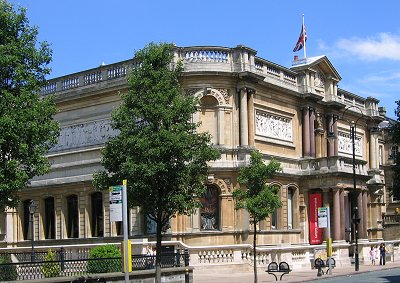
Listing: 1883-5. By J.A.Chatwin of Birmingham. Italianate style. Built
for the Wolverhampton Exhibition.
Literature: N. Pevsner, The Buildings of England:
Staffordshire, Harmondsworth, 1974 at p. 317.
Comment: The statement that it was built for the Wolverhampton
Exhibition is not a reference to the 1902
Exhibition. At the opening of this building, in 1884, there was a
large Exhibition of the Arts and Manufactures, in a temporary building on the
site of what later became the wholesale market, with a covered way connecting it
to the Art Gallery (see J. Jones, Historical Sketches of the Literary
Institutions of Wolverhampton, London, 1897). This art gallery was
certainly not built "for" that Exhibition.
The building is the only public building erected on Lichfield Street when
that street was widened. It was mostly paid for by Philip Horsman, a local
builder (who,
inter alia, built the town hall), who also did the building work here.
A fountain in St. Peter's gardens, just off the left of the photo, commemorates
this worthy's contribution to the town and is said to be erected by the grateful
townspeople. Horsman was a genuine benefactor (though some might think he
had only got the money in the first place by paying his men too little) and
liked to keep quiet about his munificence.
The upper floor has no windows, a sensible provision when the main
requirement is internal wall space on which to display painting.
So the upper galleries are top lit by windows hidden behind the parapet.
And the external blank walls are saved from aridity by having reliefs on
them. According to G. T. Noszlopy and F. Waterhouse, Public
Sculpture of Staffordshire and the Black Country, Liverpool
University Press, 2005, the sculptor was Richard Lockwood Boulton and
Sons of Cheltenham, (Presumably the executed designs by the
architect, Julius Alfred Chatwin).
 |
A detail of one of the panels on the side wall of the upper
storey (which decorate the blank walls which the galleries on the upper floor
require) depicting local industries. Here squeaky clean, immaculately dressed
and magnificently coiffed gentlemen engage in a bit of metal bashing.
|
According to Noszlopy and Waterhouse the figures on the
two panels on the side of the building personify Industry and the
Sciences. There are seventeen figures representing industry and
they include a glass maker, a book binder, a stonemason, wrought
iron workers, locksmiths, a potter and a designer. The figures
representing Science include architecture, geometry, medicine,
chemistry, geography, engineering and navigation.
| One of the two panels on the front wall, depicting
Roman ladies engaged in suitably feminine artistic activities. |
 |
 |
The other panel on the front wall, with Roman gentlemen
engaged in artistic activities. |
According to Noszlopy and Waterhouse the left hand panel
shows women personifying pottery, painting (three figures), drawing,
music, literature (two figures); and the right hand panel shows nine men
personifying sculpture.
The inclusion of a designer on the side panel is
interesting as it is unusual to see design considered separately from
other industrial activities and more likely to have been in the arts
panel, if it appeared at all. The presence of design in this panel
is likely to be related to the history of the Art School, which, under
the influence of Loveridge and Mander, and George Wallis of what later
became the Victoria and Albert Museum, was the earliest school of design
outside London.
| Originally the art gallery went back as far as the start of
the portico, seen in the photo above. The portico and the part beyond
was a separate building and was the art school. The two buildings were
separate enterprises. But when the committee which ran the art school
discovered that the new art gallery was proposed they muscled in on the act.
The council gave the land for both buildings and, although Horsman paid for
the art gallery end, the art school end was paid for by Horsman buying the
old art school buildings in Darlington Street for £2,000 and the Jones
brothers, John and Joseph giving £1,000.
S. Theodore Mander gave £250
and Henry Loveridge gave £200: they had been subsidising the art
school for years. Other donations were made and the government gave a
grant of £1,000.
It is obvious that the same architect was used for both
buildings and the building work doubtless went ahead as one. |
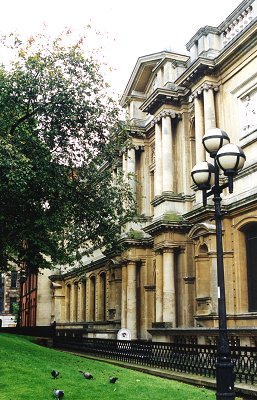 |
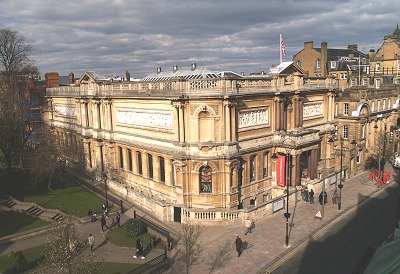 |
Financing the school and the gallery gave rise to
problems. The city council was already funding the Free Library
(and running classes there - an operation of marginal legality) and that
used up all the expenditure they were, by law, allowed for these sorts
of activities. They therefore had to promote an Act of Parliament
to allow them to raise money to pay for the art gallery and art school.
This was approved at a public meeting, sent forward to Parliament and
passed in to law on the 8th August 1887 (The Wolverhampton Corporation
Act 1885, 50 & 51 Vict. cap. clxxiv). |
It is interesting that the
Act refers to the School of Art and Science: the significance of this is
debatable. The Act authorised the council's setting up a Gallery
of Art and School of Art and Science Committee to run both buildings.
It seems that, from the start the Head of the Art School was also the
Curator of the Art Gallery. The science courses offered seem
to have been limited to Building Construction and Drawing; Machine
Construction and Drawing; and Architectural Design.
At the time the art gallery and the art school together were
seen not just as having a role in cultural enlightenment and moral uplift
but also as having a role in industry and commerce because of the
contribution they would make to industrial design. The critic, Charles
Whibley, writing in 1887, had an interesting view of the contributions these
buildings might make: "In few towns in England was an art-gallery so
imperatively required as at Wolverhampton; for, speaking frankly - to
a stranger at least - it is a dismal place. It contains neither noble
streets nor important buildings. We even look in vain for the trim
villa; and it is evident that the wealthier inhabitants live as far off as
possible from the factory chimneys, which obtrude themselves on us
everywhere, veiling the sky and seeming to blacken the surrounding
landscape. A picture gallery at the centre of such a town as this is
an inexpressible relief, and cannot fail to exercise a beneficial influence
on the inhabitants. It is to be hoped moreover that material additions
will be made to the collection of examples of the lesser arts, which at
present is but scanty; the practical advantages accruing from the
study of design and handicraft will then be directly manifested".
This art gallery is one of three such facilities in the
city. The Bilston Craft Gallery is a regional gallery which exhibits
craft work from the region, Bantock House is the local history museum and
this building, the Wolverhampton Art Gallery, is the place for the visual
arts. The basis of its collection was gifts made at or shortly after
the building's opening by Sidney Cartwright, Philip Horsman and Paul Lutz,
James Beattie and others (totalling some 50 paintings). The Jones Brothers
also gave £1,000 for acquisitions. A few years later Mrs Marie Christian
Cartwright bequeathed the collection (of about 275 paintings) she and her
husband, Sidney, had accumulated over the years; it was valued, at the time,
at £17,000 - a lot more than the cost of the building. Probably
because of George Wallis' connection with the town, the gallery in its early
years also received a collection of material from the V & A, including
Elkington electrotypes.
In a review of the art gallery published in the Magazine of
Art in December 1887, Charles Whibley mentions that there were some works by
modern artists and some genre paintings; but, he says, the collection
is particularly strong in the art of forty years ago - when British art was
uncompromisingly British and "untouched by foreign influence" - and
therefore contains many wonderful landscapes.
Now the art gallery occupies the original building and the
part behind (which was originally the art school) and the brick building
beyond that (which was originally an addition to the art school). The
two main galleries on the upper floor house displays of Victorian art and of
Georgian Art, with a commendable attempt to put them into a social context.
In the Victorian collection the gallery claims to have the UK's finest
collection of the Cranbrook Colony of painters; and it also has works by
many Victorian standards such as Landseer. In the Georgian collection
- which was greatly augmented in the 1970s by grants from the V&A - there
are works by Gainsborough, Zoffany, Fuseli, Wright of Derby and others.
The gallery is also strong on 20th century art, the basis of
which is the collection given by Anthony Twentyman and an unusual acquisition
policy in the 1960s. There are painting by Lichtenstein and Warhol and
much pop art.

From an old postcard.
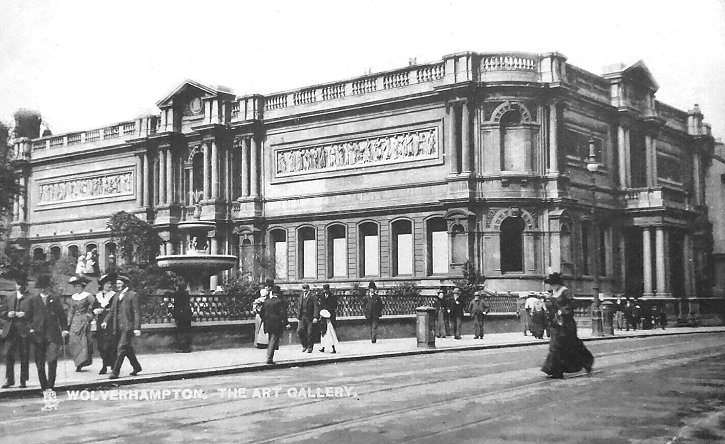
From an old postcard.
The art gallery used also to contain an exhibition of local
history; some of this has now moved to the excellent local history museum in
Bantock House. The rest is presumably in storage somewhere and really
ought to be on display somewhere - anywhere.
The gallery has often been in periods of doldrums, mostly caused
by funding shortages, interspersed with periods of enterprise. A short period
when the gallery put on extremely enterprising exhibitions, such as "One for the
Pot" - a history of tea drinking, complete with waitresses in Victorian dress,
serving afternoon tea in a palm court - is well remembered.
In recent years the exhibitions have been the expected
touring exhibitions and local art shows, and occasional locally curated
shows of more than a little enterprise and imagination. Currently the main,
original, galleries are about as well, and as inter-actively, set up as may
be.
The building is currently nice and clean on the outside and
rather well and appropriately decorated inside. During most of 2001 the
gallery was closed for a good deal of refurbishment and additions.
These were said to be needed to meet modern requirements; but they
were also needed to stop the rain getting in. The galleries were not
much changed but the storage and working areas were.
| In 2003 funding of £6.7 million was obtained from various
sources to build a brand new set of flashy glass and steel
galleries in what is currently the back yard. This was due
to start in April 2004 but, of course, did not. It
eventually got going in January 2005 and was opened in 2007.
The back of the original part was most unattractive and it faced
a desolate and scruffy courtyard. The new galleries had to
fit in with the Georgian and Victorian red brick buildings to
each side and make the best use of the old courtyard space. The
external appearance which resulted is about as good as could
have been expected, once a misguided proposal to cover most of
the exterior with a memorial to the Lunar Society of Birmingham
had been fought off. |
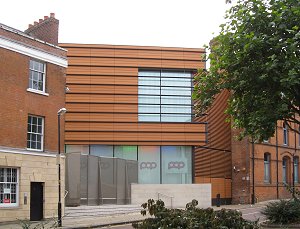 |
Inside the part
which was the old Art School has been changed beyond recognition and new,
high spec, galleries added. They look pretty good. Their main purpose
is said to be to display the gallery's large collection of Pop Art and this
is expected to draw art students and enthusiasts from far and near.
One waits and, so far, one does not see.
Some people held the view that the best feature of the
art gallery was the excellent cafe. As part of the work on the
extensions the cafe was rebuilt, on two levels, and in the best glass
and steel type of modern design. It is now once again the best
feature of the gallery.

|